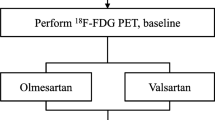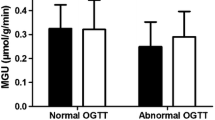Abstract
The purpose of this study was to assess whether acute angiotensin-converting enzyme (ACE) inhibition would improve myocardial perfusion and perfusion reserve in a subpopulation of normotensive patients with diabetes and left ventricular hypertrophy (LVH), both independent risk factors of coronary disease. Using positron emission tomography (PET), we investigated the response of regional myocardial perfusion to acute ACE inhibition with i.v. infusion of perindoprilat (vs saline infusion as control, minimum interval 3 days) in 12 diabetic patients with LVH. Myocardial perfusion was quantified with PET using nitrogen-13 ammonia infused at rest and during dipyridamole hyperaemia. Twelve healthy control subjects were included in the study, five of whom were also studied with perindoprilat. Mean blood pressure in normo-albuminuric, asymptomatic patients was 123±7/65±9 mmHg. Compared with controls, maximal perfusion was reduced in patients (1.8±0.6 vs 2.5±1.0 ml min−1 g−1; P<0.05), and perfusion reserve was also lower, at borderline significance (2.7±1.0 vs 3.6±1.3; P=0.059). During perindoprilat infusion, myocardial perfusion reserve in patients increased to 3.9±0.9 (P<0.001) due to normalisation of maximal perfusion (2.3±0.5 ml min−1 g−1, P<0.01). In the five control subjects both resting and hyperaemic perfusion remained unchanged during perindoprilat infusion. It is concluded that acute ACE inhibition with perindoprilat improves maximal achieved myocardial perfusion in non-hypertensive patients with diabetes and LVH.



Similar content being viewed by others
References
Haffner SM, Lehto S, Ronnemaa T, Pyorala K, Laakso M. Mortality from coronary heart disease in subjects with type 2 diabetes and in nondiabetic subjects with and without prior myocardial infarction [see comments]. N Engl J Med 1998; 339:229–234.
Miettinen H, Lehto S, Salomaa V, Mahonen M, Niemela M, Haffner SM, Pyorala K, Tuomilehto J. Impact of diabetes on mortality after the first myocardial infarction. The FINMONICA Myocardial Infarction Register Study Group. Diabetes Care 1998; 21:69–75.
Nielsen FS, Ali S, Rossing P, Bang LE, Svendsen TL, Gall MA, Smidt UM, Kastrup J, Parving HH. Left ventricular hypertrophy in non-insulin-dependent diabetic patients with and without diabetic nephropathy. Diabet Med 1997; 14:538–546.
Rutter MK, McComb JM, Forster J, Brady S, Marshall SM. Increased left ventricular mass index and nocturnal systolic blood pressure in patients with type 2 diabetes mellitus and microalbuminuria. Diabet Med 2000; 17:321–325.
Levy D, Garrison RJ, Savage DD, Kannel WB, Castelli WP. Prognostic implications of echocardiographically determined left ventricular mass in the Framingham Heart Study. N Engl J Med 1990; 322:1561–1566.
Johnstone MT, Creager SJ, Scales KM, Cusco JA, Lee BK, Creager MA. Impaired endothelium-dependent vasodilation in patients with insulin-dependent diabetes mellitus. Circulation 1993:2510–2516.
Williams SB, Cusco JA, Roddy MA, Johnstone MT, Creager MA. Impaired nitric oxide-mediated vasodilation in patients with non-insulin-dependent diabetes mellitus. J Am Coll Cardiol 1996; 27:567–574.
Perticone F, Maio R, Ceravolo R, Cosco C, Cloro C, Mattioli PL. Relationship between left ventricular mass and endothelium-dependent vasodilation in never-treated hypertensive patients. Circulation 1999; 99:1991–1996.
Treasure CB, Klein JL, Vita JA, Manoukian SV, Renwick GH, Selwyn AP, Ganz P, Alexander RW. Hypertension and left ventricular hypertrophy are associated with impaired endothelium-mediated relaxation in human coronary resistance vessels. Circulation 1993; 87:86–93.
Lovell HG. Angiotensin converting enzyme inhibitors in normotensive diabetic patients with microalbuminuria. Cochrane Database Syst Rev 2000:CD002183.
Malik RA. Can diabetic neuropathy be prevented by angiotensin-converting enzyme inhibitors? Ann Med 2000; 32:1–5.
Yusuf S, Sleight P, Pogue J, Bosch J, Davies R, Dagenais G. Effects of an angiotensin-converting-enzyme inhibitor, ramipril, on cardiovascular events in high-risk patients. The Heart Outcomes Prevention Evaluation Study Investigators. N Engl J Med 2000; 342:145–153.
Nielsen FS, Sato A, Ali S, Tarnow L, Smidt UM, Kastrup J, Parving HH. Beneficial impact of ramipril on left ventricular hypertrophy in normotensive nonalbuminuric NIDDM patients. Diabetes Care 1998; 21:804–809.
O’Driscoll G, Green D, Rankin J, Stanton K, Taylor R. Improvement in endothelial function by angiotensin converting enzyme inhibition in insulin-dependent diabetes mellitus. J Clin Invest 1997; 100:678–684.
Arcaro G, Zenere BM, Saggiani F, Zenti MG, Monauni T, Lechi A, Muggeo M, Bonadonna RC. ACE inhibitors improve endothelial function in type 1 diabetic patients with normal arterial pressure and microalbuminuria. Diabetes Care 1999; 22:1536–1542.
O’Driscoll G, Green D, Maiorana A, Stanton K, Colreavy F, Taylor R. Improvement in endothelial function by angiotensin-converting enzyme inhibition in non-insulin-dependent diabetes mellitus. J Am Coll Cardiol 1999; 33:1506–1511.
Devereux RB, Reichek N. Echocardiographic determination of left ventricular mass in man: anatomic validation of the method. Circulation 1977; 55:613–618.
Pitkanen OP, Nuutila P, Raitakari OT, Ronnemaa T, Koskinen PJ, Iida H, Lehtimaki TJ, Laine HK, Takala T, Viikari JS, Knuuti J. Coronary flow reserve is reduced in young men with IDDM. Diabetes 1998; 47:248–254.
Yokoyama I, Momomura S, Ohtake T, Yonekura K, Nishikawa J, Sasaki Y, Omata M. Reduced myocardial flow reserve in non-insulin-dependent diabetes mellitus. J Am Coll Cardiol 1997; 30:1472–1477.
Buus NH, Böttcher M, Hermansen F, Sander F, Nielsen TT, Mulvany MJ. Influence of nitric oxide synthase and adrenergic inhibition on adenosine-induced myocardial hyperemia. Circulation 2001; 104:2305–2310.
Taddei S, Favilla S, Duranti P, Simonini N, Salvetti A. Vascular renin-angiotensin system and neurotransmission in hypertensive persons. Hypertension 1991; 18:266–277.
Mombouli JV, Vanhoutte PM. Kinins and endothelium-dependent relaxations to converting enzyme inhibitors in perfused canine arteries. J Cardiovasc Pharmacol 1991; 18:926–927.
Zanzinger J, Czachurski J, Seller H. Inhibition of sympathetic vasoconstriction is a major principle of vasodilation by nitric oxide in vivo. Circ Res 1994; 75:1073–1077.
Clemson B, Gaul L, Gubin SS, Campsey DM, McConville J, Nussberger J, Zelis R. Prejunctional angiotensin II receptors. Facilitation of norepinephrine release in the human forearm. J Clin Invest 1994; 93:684–691.
Mancini GB. Long-term use of angiotensin-converting enzyme inhibitors to modify endothelial dysfunction: a review of clinical investigations. Clin Invest Med 2000; 23:144–161.
Giugliano D, Marfella R, Acampora R, Giunta R, Coppola L, D’Onofrio F. Effects of perindopril and carvedilol on endothelium-dependent vascular functions in patients with diabetes and hypertension. Diabetes Care 1998; 21:631–636.
Mullen MJ, Clarkson P, Donald AE, Thomson H, Thorne SA, Powe AJ, Furuno T, Bull T, Deanfield JE. Effect of enalapril on endothelial function in young insulin-dependent diabetic patients: a randomised, double-blind study. J Am Coll Cardiol 1998; 31:1330–1335.
McFarlane R, McCredie RJ, Bonney MA, Molyneaux L, Zilkens R, Celermajer DS, Yue DK. Angiotensin converting enzyme inhibition and arterial endothelial function in adults with type 1 diabetes mellitus. Diabet Med 1999; 16:62–66.
Motz W, Strauer BE. Improvement of coronary flow reserve after long-term therapy with enalapril. Hypertension 1996; 27:1031–1038.
Nitenberg A, Antony I. Acute effects of angiotensin-converting enzyme inhibition on coronary vasomotion in hypertensive patients. Eur Heart J 1998; 19 Suppl J:J45–J51.
Schneider CA, Voth E, Moka D, Baer FM, Melin J, Bol A, Wagner R, Schicha H, Erdmann E, Sechtem U. Improvement of myocardial blood flow to ischaemic regions by angiotensin-converting enzyme inhibition with quinaprilat IV: a study using [15O] water dobutamine stress positron emission tomography. J Am Coll Cardiol 1999; 34:1005–1011.
Rubanyi GM, Romero JC, Vanhoutte PM. Flow-induced release of endothelium-derived relaxing factor. Am J Physiol 1986; 250 Pt 2:H1145–H1149.
Leipert B, Becker BF, Gerlach E. Different endothelial mechanisms involved in coronary responses to known vasodilators. Am J Physiol 1992; 262 Pt 2:H1676–H1683.
Mayhan WG. Endothelium-dependent responses of cerebral arterioles to adenosine 5’-diphosphate. J Vasc Res 1992; 29:353–358.
Kaufmann PA, Gnecchi-Ruscone T, Terlizzi M, Schäfers KP, Lüscher TF, Camici PG. Vitamin C restores coronary microcirculatory function. Circulation 2000; 102:1233–1238.
Rossen JD, Simonetti I, Marcus ML, Winniford MD. Coronary dilation with standard dose dipyridamole and dipyridamole combined with handgrip. Circulation 1989; 79:566–572.
Wilson RF, Wyche K, Christensen BV, Zimmer S, Laxson DD. Effects of adenosine on human coronary arterial circulation. Circulation 1990; 82:1595–1606.
Czernin J, Auerbach M, Sun KT, Phelps M, Schelbert HR. Effects of modified pharmacologic stress approaches on hyperaemic myocardial blood flow. J Nucl Med 1995; 36:575–580.
Chan SY, Brunken RC, Czernin J, Porenta G, Kuhle W, Krivokapich J, Phelps ME, Schelbert HR. Comparison of maximal myocardial blood flow during adenosine infusion with that of intravenous dipyridamole in normal men. J Am Coll Cardiol 1992; 20:979–985.
Gall M-A, Rossing P, Skøtt P, et al. Prevalence of micro- and macroalbuminuria, arterial hypertension, retinopathy and large vessel disease in European type 2 (non-insulin dependent) diabetic patients. Diabetologia 1991; 34:665–661.
Acknowledgements
We would like to thank Sam Gambhir for the supply of the SIMPLE software package, Helle Jung Larsen for her technical assistance and Ulrik Hesse for his help with the statistical calculations.
The study was supported by grants from the Danish Heart Foundation, Servier International, and the John and Birthe Meyer Foundation.
Author information
Authors and Affiliations
Corresponding author
Appendix
Appendix
PET scanning acquisition
The study was performed with a whole-body tomograph (Advance, General Electric Medical Systems, Milwaukee, WI), with 18 crystal rings forming 35 two-dimensional imaging planes spaced by 4.25 mm, and an intrinsic spatial resolution of 4–6 mm full-width at half-maximum (FWHM). The gantry width had a diameter of 55 cm, and the axial field of view was 15.2 cm. Two pin sources with germanium-68 were used for the blank and transmission scan acquisitions. Corrections for dead time, random sequence, attenuation, scatter and decay were applied and the images were reconstructed to an effective in-plane resolution of 7 mm FWHM, using a Hanning filter. Initially a 2-min transmission scan was performed for optimal positioning, which was then checked during the study by a cross-shaped low-power laser beam and pen markers on the skin. Movements were minimised by fastening a Velcro strap over the chest.
Analysis of the PET studies for calculation of myocardial perfusion
For each frame of the serially acquired data, sets of 35 transaxial images were reconstructed. Each of these image data sets was re-sampled on a work station (General Electric Medical Systems, Milwaukee, WI ) into 12 contiguous short-axis cross-sections of the left ventricle. To generate time-activity curves, six serially acquired short-axis cross-sections (two basal, two mid-ventricular and two apical) were selected in each subject, leaving out the four most apical and the two most basal planes. The definition of the regions of interest (ROI) was the only observer-dependent part of the analysis; ROIs were assigned onto the last serial image (900 s), in a blinded manner regarding perindoprilat or placebo administration, and copied to the first 16 serially acquired 13N-ammonia images (i.e. the initial 120 s of data after tracer injection) to obtain regional time-activity curves. Rectangular, myocardial ROIs with an area of 64 mm2 were placed corresponding to the anterior, lateral and inferior wall of the left ventricle using a standardised template. The junction of the anterior right ventricular wall with the anterior interventricular septum was used to ensure standardised anatomical location of the template. The septal ROI was omitted in our analysis to reduce the error introduced by dual spill-over from the right and the left ventricular cavities. The time-activity curves from three corresponding sectors in six planes were then averaged. A circular ROI, with an area of approximately 50 mm2, was placed in the centre of the LV blood pool to derive the arterial concentration curve for input function, averaging the input time-activity curves from the three most basal planes. We corrected for partial volume effects with an individually estimated recovery coefficient taking into account the image FWHM, the ROI width and the values of the subject’s LV free wall thickness. The corrected time-activity curves were then fitted with a two-compartment tracer kinetic model.
Rights and permissions
About this article
Cite this article
Hesse, B., Meyer, C., Nielsen, F.S. et al. Myocardial perfusion in type 2 diabetes with left ventricular hypertrophy: normalisation by acute angiotensin-converting enzyme inhibition. Eur J Nucl Med Mol Imaging 31, 362–368 (2004). https://doi.org/10.1007/s00259-003-1388-6
Received:
Accepted:
Published:
Issue Date:
DOI: https://doi.org/10.1007/s00259-003-1388-6




